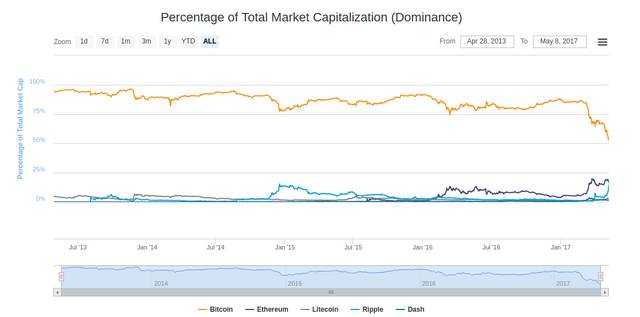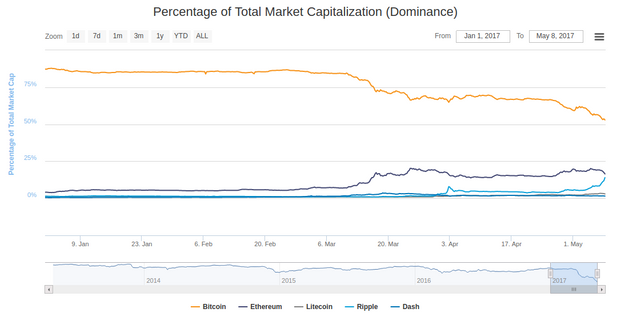Bitcoin dominance and network effects analysis

Since the Bitcoin ETF was declined by SEC, Bitcoin has risen in price from ~$1200 to ~$1600 (correlation doesn't imply causation!). Not an insignificant increase but bitcoin holders have a reason to be nervous: bitcoin dominance has fallen sharply and is at all time low, hovering just above 50%.
And it's certainly hasn't gone unnoticed by the cryptocurrency media.
- Coindesk
- Cointelegraph
- Btcmanager
- The Merkle
- Live Bitcoin News
- Finance Magnates
- Bitcoins Channel
- Lets talk payments
- Bitcoin.xyz
- Reddit 0
- Reddit 1
- Reddit 2
- Hacker news
The dominance bear trend
Bitcoin dominance is calculated by dividing BTC market cap by the market cap of all cryptocurrencies in percent. Let's have a look at the historical bitcoin dominance charts.


Preface
Understanding network effects is absolutely NOT enough to understand bitcoin dominance metrics. An exhaustive list of concepts should at least include the following topics: complexity theory, chaos theory, game theory, behavioural economics, computer science and cryptography, switching costs, first mover advantages and ever-changing contexts.
Network effects
Network effects are important! Startup and VC industry have a lot of valuable insights for cryptocurrency, they both operate in the hyper-growth, hyper-uncertainty space. Let's use some.
VCs love their portfolio companies to have an unfair advantage. Which is also called a moat. So let's look at what top VCs say about network effects.
Network effects. It’s one of the most important concepts for business in general and especially for tech businesses, as it’s the key dynamic behind many successful software-based companies. Understanding network effects not only helps build better products, but it helps build moats and protect software companies against competitors’ eating away at their margins.
All about Network Effects / Andreessen-Horowitz
We shouldn't take advice by VCs at face value though, right?
Let's proceed. Network effect (also called network externality or demand-side economies of scale) is the effect that one user of a good or service has on the value of that product to other people.
All cryptocurrencies exhibit strong positive network effects (obviously) and bitcoin has the strongest one. Network effects are said to be following Metcalfe's law (not really a law though) where the value of the network increases proportionally to the number of connections squared.
Metcalfe's law is just a model, though. And it's wrong. But it's also useful!
There is an alternative model of value growth quantification in Metcalfe's law proposes a n log n curve instead of n^2.
Network effects are hard
A lot of startups founders in a platform play are intimately acquainted (and not in a good way!) with network effects, which are also called a chicken and egg problem.
The utmost importance of network effects is well known and isn't controversial.
Just have a look at this fine selection of quotes:
Marketplace businesses: they always seem great on paper, but it’s so insanely hard to solve the chicken-or-the egg problem.
Every founder I meet who’s building a marketplace business basically says the same thing: “It’s so much harder than I thought to build a two-sided marketplace.“
by Josh Breinlinger who is a venture partner at Sigma West. Prior to venture capital, he was the 4th employee at oDesk and helped grow the marketplace over 5 years in a variety of leadership roles.
“When you have a two-sided platform, you have to acquire both the customers and the services,” says Harvard Business School’s Thales Teixeira, Lumry Family Associate Professor of Business Administration.
“It’s the classic chicken-and-egg problem,” he says. You can’t have one without the other, but which one do you find first—the customer chicken or the service egg?
by Harvard Business School’s Thales Teixeira, Lumry Family Associate Professor of Business Administration.
Bitcoin's all you can eat chicken-and-egg buffet
We've already established that solving chicken-and-eggs problem is really hard. So why would "altcoins" (such a misnomer, btw) grow their networks and ecosystems so quickly?
Well, ridiculous bitcoin txs fees and congested blocks -> less transactions -> less connections between network users -> less value to the network users. But it's not that simple.
Bitcoin stakeholders were not able to build an unassailable moat that would defend the BTC network value. That's just a fact. Altcoins were supposed to be a "testing bed for new bitcoin features", weren't they?
Yes, it seems that network stakeholders need to cooperate to design and implement strategies to grow the network and compete with chains and tokens offering substitute services. Who would have thought?
Network effects are not a blockchain-god given right of a first mover. They just aren't. Just ask myspace or friendster.
Steem network effects
Steem has a different "set" of network effects: unlike Bitcoin wallets, Steem users form personal connections within the network. It can be rewarding to think about how this changes network topology, switching costs and value generation.
Thanks for sharing! In my opinion, it looks that we are entering bubble territory for a vast majority of alt coins (except Bitcoin probably). Just think about and analyze the following facts:
At least several dozens alt coins market caps skyrocketed 300%-4000%(yes, four thousand!) recently just over last 2 months!
The beginning of sharp increase happened around middle of March of 2017 for ALL alt coins!
Yes, some alt coins sharp increase is logically justifiable. For example, Ripple XRP: http://www.cnbc.com/2017/03/01/japanese-banks-plan-to-adopt-blockchain-for-payments.html . Maybe there are couple other alt coins where this huge growth is also justifiable.
But for vast majority of other alt coins nothing has changed drastically during the last 2 months! At all! Neither in their technologies development, nor in their business development! But nevertheless, their market cap skyrocketed 300%-4000% in just 2 months!
The only explanation which comes to mind is that huge amount of new capital is coming to cryptocurrencies market. Probably these are the people/investors who have heard about the first wave of Bitcoin and Ethereum successes, and they have a FOMO (fear of missing out) now. They don't have deep understanding of cryptocurrencies space and their differences, but because of FOMO they still invest in all other alt coins hoping to hit jackpot!
Does it remind you anything? Yes, exactly, dot com bubble of 2000 looks very similar!
Therefore, I would expect some kind of significant downside price correction within next several months for the majority of alt coins. Would you agree?
nice!